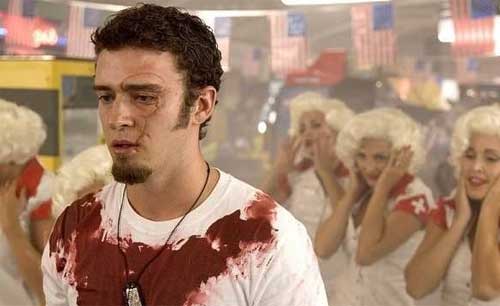Title:
Wild Beasts
Director: Franco Prosperi
Released: 1984
Starring: Lorraine de Selle, John Aldrich,
Ugo Bologna, Louisa Lloyd, John Stacy
Plot: A large quantity of PCP finds its way
into the local water supply, which also happens to be the main supply for the
city zoo. Now driven wild the animals escape and wreak havoc in the city
Review:
One of the best creations for film fans in recent times especially for bloggers
/ critics looking for their next watch is the site “Letterboxd” which
essentially provides the same service as “Good Reads” only for movies instead
of books. Ok it might seem alittle random to be opening with a recommendation
of a film site, but honestly without it I would have never have stumbled across
this little slice of deep fried animals gone wild fun!
Just
looking at the plot alone makes this worth giving it a curious watch, so it
only makes it all the better when it lives up to its premise. True it might be
essentially the same as every other film in the genre with man once again
finding a way of screwing up and inturn enraging the local animal population
and being forced to pay the price when said animals strike back. The only thing
which honestly sets it apart from the numerous other films in the genre is the
fact that its drugs driving the animals wild than the usual environmental threats
such as sewage or construction encroaching on the animals territory.
An
oddity on director Prosperi’s resume having spent most of his career directing
Mondo movies (documentaries focusing on shocking subjects) and crime drama’s
and despite the film opening with a title card assuring the audience that no
animals were harmed during filming, its soon clear that Prosperi hasn’t drifted
from his Mondo roots as the film does in fact feature scenes of real rats being
set on fire and a lion set preying on a cow to name but two scenes which
seriously question this claim. Thankfully this is no way the same ballpark of
animal cruelty like “Cannibal Holocaust” with its nightmare inducing turtle
scene while they are equally so brief that they don’t detract from the film
like that scene did.
Unlike
so many other films in the genre the animal attacks are pretty frequent here
and not spaced out with questionable plotting to pad out the runtime. This
however is not to say that the plot is any better here as cult cinema favourite
De Selle gets to take a break from her usual shockers like “Cannibal Ferox” and
“House at the Edge of the Park” with this film being notably lighter as here
she appears as Dr. Laura Schwarz who has to team up with Super Mario look-alike
and zoo keeper Rupert (Aldrich) to stop the rogue animals while trying to get
to the bottom of what’s driving them crazy. We also have the random plotline
concerning Laura’s daughter who’s attending a ballet class while the city
erupts into chaos and which serves little purpose outside of setting up the
films finale.
The
plot is pretty non-existent and generally serves to get the film from one
animal attack set-piece to the next, while Prosperi still managing to find a
number of random moments to scatter throughout the film such as shots of piles
of syringes in the opening which have nothing to do with the PCP getting into
the water supply which bizarrely never get explained as to how it got in the
water in the first place. We also have scenes such as Laura phoning her daughter
only to have the kid randomly have a frog puppet squawk down the phone. The
standout moment of random plotting though has to be the ending which takes
place at the dance school, were the film suddenly switches into a psycho child
movie thanks to the dance school students really loving that water cooler!
The
real selling point here though is animal attack scenes which are numerous to
say the least with Prosperi certainly making the most of the premise starting
with a group of rabid rats preying on a couple making out in a car in a scene
which also sees a cat also falling foul to these rats. From here Prosperi seems
to constantly be looking for a way to top the last scene as we get the expected
scenes of zoo keepers being attacked by wild cats alongside more random scenes
like a girl trying to outrun a cheetah in her bang up beetle and my personal
favourite the girl having her head squashed by an elephant, the same elephants
who in perhaps a cinematic first are also responsible for a jumbo jet crashing
when they stumble onto the runway.
While
not as shocking as some of his earlier films, Prosperi still includes a few
shocking scenes, especially in terms of the animal cruelty but ultimately this
is a fun romp and certainly one of the few examples of this kind of movie which
manages to live up to the hype selling it. Yes the performances might be
frequently questionable and the saxophone heavy soundtrack certainly a product of
its time. However when the animal attack scenes are so much fun and inventive it’s
easy to look past a lot of the issues here while fans of these kinds of movie
will unquestionably find much to enjoy here making it well worth hunting down.
























